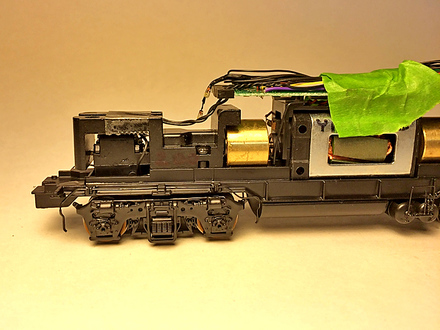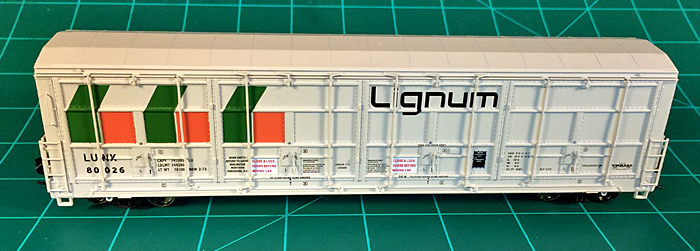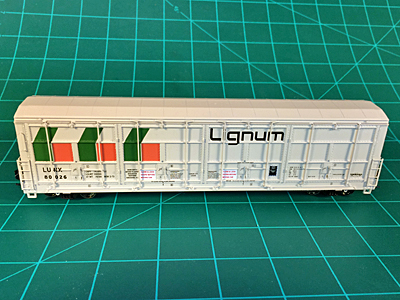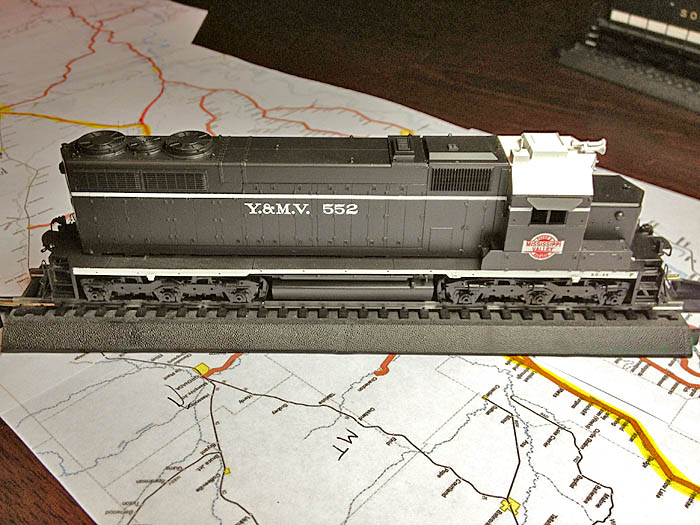Primer Coat Fail - Scalecoat II PaintIn anticipation of the arrival of Y&MV Thrall-Door boxcar decals currently under development, I decided to get ahead of the game and spray primer on the first two cars. I have decided on a paint formula for my Y&MV freight cars. The paint will be a mix of 75% Scalecoat II S2027 IC Orange and 25% Scalecoat II S2012 Tuscan Red. For the primer I used Scalecoat II S2041 Erie Lackawanna Grey and added a bit of the IC Orange and Tuscan Red to begin the color transition to the end product. I replaced the couplers and trucks with shop trucks and shop couplers for handling and painting. I like to use those old, useless horn-hook couplers when painting cars as they make excellent handles for positioning and carrying the cars. The texture of the spray was a little disappointing. It is a little grainy or "splotchy" for lack of a better word. I sprayed these cars in the garage which is my normal spraying environment The temperature was 94° with 48% humidity. While the texture of this finish is unacceptable, I believe it can be corrected with a more controlled spray of the final color. As a side note, Scalecoat Paint has been purchased MinuteMan Scale Models. Hopefully this will ensure the future availability of these colors, unlike the Testor's genocide of the Floquil line of paints...yes, I am still not happy about that one. Are the cars salvageable....? We shall see.
Chris
4 Comments
iPhone 5S Model Photography - LUNX 80026 As part of the Y&MV Thrall-Door boxcar project I created a detail page for the Walthers model of car LUNX 80026. Though this car will be repainted and it is unlikely that a car painted in this attractive Lignum scheme will operate across the Meridian Speedway, this car comes with exquisite markings that can serve as an exceptional reference for the creation and placement of decals on the Y&MV cars. For model photography I have leaned heavily on the camera that comes standard in my iPhone versus the more heavyweight Canon cameras in my photography arsenal. For individual roster shots and even closeups up-to a half a car in size, the regular view of the iPhone camera is just fine. Today's HO scale models have incredible detail at the fine-print level, however. These details can be difficult to capture with the depth-of-field limitations of many cameras. To capture these small markings, I actually moved the iPhone farther away from the model and then zoomed in on the fine print to capture the image. Now I can easily read this microscopic writing on my computer screen. To read all of this writing on the car would require a magnifying glass and much patience. To view the slideshow of all of the detail images of car LUNX 80026, visit this car's detail page by clicking on the images or the button above! Chris
 Another one of the many projects underway is the development of the image and decals for Y&MV freight cars. The Y&MV has contracted Stephens Rail Car to develop freight car decals for this railroad. The first car type to be focused on is the Thrall All-Door Boxcar. There are 45 of them on the Y&MV freight car roster, Nos. 2000-2044. Y&MV management has provided Stephens Rail Car lettering specifications in a text format. The above image is the first visual mock-up which has come back from Stephens Rail Car. This is a very impressive step in the right direction! There will be continued communication between the two companies as the details are fine-tuned. Hank Stephens of Stephens Rail Car is excellent to work with. The decals once finalized will be printed by Highball Graphics Decals. Y&MV Thrall All Door BoxcarThe Y&MV Vicksburg Shops has a number of these Thrall All-Door Boxcars on-hand for repainting. These unique cars were specially designed for the lumber industry which is a major contributor to the Y&MV's total traffic base. Below are images of a couple of the cars that will soon be painted and letterd for the Y&MV: BNSF K-ALTALT1-23 Tests Tier IV ET44C4's GE announced on the morning of June 23, 2015 that they would be needing the BNSF "GE Job" K-ALTALT1-23 to test brand-new ET44C4 Tier IV locomotives BNSF 3917 and BNSF 3920. They were ready to roll after the passing of the southbound Amtrak Heartland Flyer. Today's test run would take them Northward to Metro. After work I grabbed the camera and headed to Metro to get-the-shot. I arrived just in time as the power was departing southbound for GE. BNSF Tier IV No. 3916 was the first and only one to be previously released from the GE plant and it had wandered off-line for testing. The units today would be the first pair of production BNSF Tier IV's to operate together outside of the GE plant. The low speed testing allowed me to get shots at five locations between Metro, Texas and Justin, Texas. The lighting was not bad at all! At Justin the K-ALTALT1-23 held for a better signal indication. The last shots of the day were of the train ahead, Tulsa, OK to Teague, TX train H-TULTEA1-22 pulling the grade on Main Track 3 at North Haslet--right by the edge of the current runway at Alliance Airport. Click on the images in this slide show to view larger files! Chris Car Forwarding in N-ScaleAn additional page has been added to the notes and photos in the Operating Session Library detailing the Car Tab System used by Dean Ferris on his N-scale model railroad. Car Tabs are just one method of aiding operators with the movement of rail cars across a railroad. The button below will take you to this page: Chris Slide Show from Dean Ferris' N-scale Ops Session
Chris Dean Ferris' Northern Pacific Oregon Joint Line in N Scale This weekend I was fortunate enough to have been able to operate on Dean Ferris' N Scale Northern Pacific Oregon Joint Line model railroad. Set in 1969, this model railroad offers enough challenges to keep an 11-person crew busy for an operating session. I have added notes and photos from this session to the Meridian Speedway Operating Session Library. Additionally the buttons below will take you to Dean Ferris' YouTube video of time-lapsed images taken at Monument Yard during this operating session. Fellow operator Greg McComas also posted a write-up of his experience at this operating session on his Michigan Interstate blog. The slide show posted hi-lights the experience of the first train I operated during this operating session, NP No. 664. I will be posting additional slide shows from this operating session over the next week or so. Chris
Black Paint on Truck Sideframes - YMV 200/201/552 This step has taken a while to complete, primarily due to time allotment as well as complications requiring a second application of paint. Once the trucks were disassembled, care was taken to mask the wheel and gearbox combos as well as all of the machinery above the frame. The truck side frames themselves were left "attached" to the main locomotive by a single soldered wire for electrical pickup. On the Athearn Genesis models, the metal contact strip which completes the electrical circuit from the axle ends to the jumper wires leading to the circuit board are "riveted" to the inside of the truck side frames with melted plastic tabs. To maintain the integrity of this electrical path, masking tape was applied over this strip at every axle contact location.  During this process the wheels were brush painted with Floquil rust a total of three times. While most of the wheels will not be visible behind the truck side frames, the rust portions bring out an additional level of detail that will be noticed as the locomotives are photographed over the years to come. Since the wheels on Y&MV SD35 552 had not been painted yet, I decided to include this unit in the process. Truck disassembly with this Atlas locomotive was a bit easier than on the Athearn Genesis GP7u's as the metal axle contact strips were not fixed to the truck side frames, allowing them to separate completely from the locomotive. Both the wheels and truck side frames of the Y&MV 552 were painted at the same time as those of the GP7u's. The truck side frames were airbrushed with a thinned coat of Floquil Engine Black. The molded silver plastic truck side frames on the Athearn Genesis GP7u's actually have a repellent property which caused the Floquil paint to run away from the corners and details. I did not notice the effect on the black plastic Atlas side frames, though it would have been harder to notice due to the plastic and the paint being the same color.  I put the project aside and allowed the Floquil paint to dry for several weeks while I focused on other items. Last week I revisited this project. This time I ran non-diluted Scalecoat II S2001 Loco Black paint through the airbrush. Part of the reason I waited so long was because I wanted to ensure there was no reaction between the two different brands of paint. This time the paint went on very smoothly and evenly. There was no evidence of the repelling effect that the naked plastic had on the first coat of Floquil paint. The project was put aside for a few days to dry thoroughly. The side frames on all three locomotives were put back on the locomotive truck assemblies. On each of the GP7u's one of the truck side frames came lose as the wire broke at the solder location. As the circuitry is redundant the locomotive operate just fine under power. The wires are VERY thin, however, and certainly the integrity of the remaining six connected truck side frames may be compromised. These electrical contacts will be revisited during the DCC decoder installation process. Chris The Meridian Speedway in Louisiana posted in Library Not too long ago I reached out to my father and asked him to write an essay outlining the history of The Meridian Speedway in Louisiana. He accepted the challenge and has completed the assignment which can be found in the Selected Reading Index of the Meridian Speedway Library on this site. Accompanying the article are a number of images taken by my father as well as several blueprints of interest which were shared by Mick Nussbaum. This article will nicely compliment an article currently being penned by J. Parker Lamb on the role of Michael Havery and the KCS in incorporating this key route into the modern corridor that would be dubbed "The Meridian Speedway". I look forward to sharing that work in the near future! Many thanks to my father for authoring and contributing this article! Chris One of many current projects - I am working with the experts on developing decals for my Y&MV freight cars. One of the most important features are the road numbers....so the Y&MV Freight Car Roster is now created and posted under the Meridian Speedway operations tab! Chris
|
Categories
All
Author:
|
Proudly powered by Weebly
- - - Homepage of the Natchez Trace and Orient Railway and Texas and Great Northern Railway - HO Scale Meridian Speedway - Created by Christopher M. Palmieri - - -
© Christopher M. Palmieri - 1st Publish 12-10-2014
© Christopher M. Palmieri - 1st Publish 12-10-2014







 RSS Feed
RSS Feed



